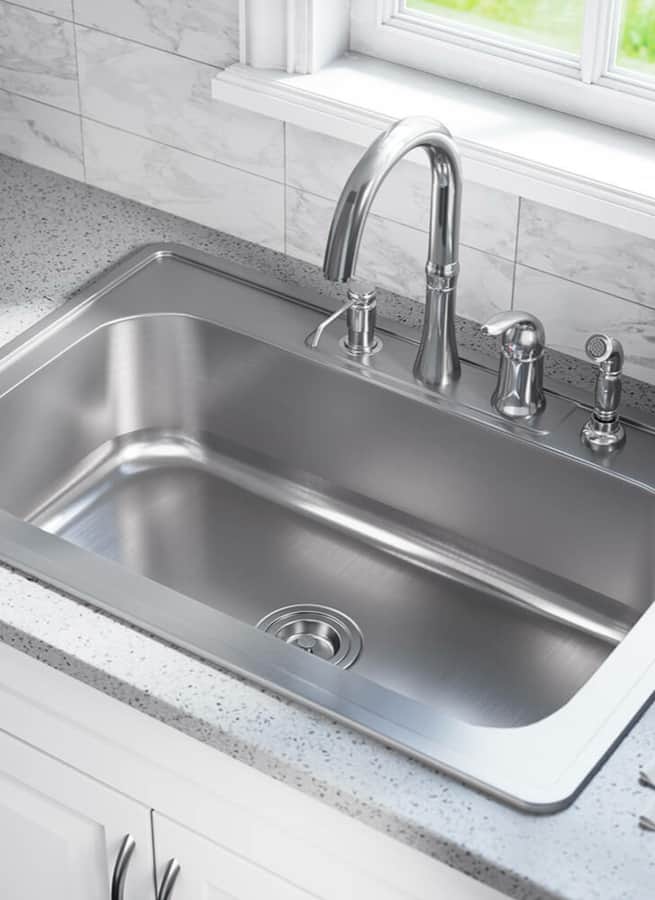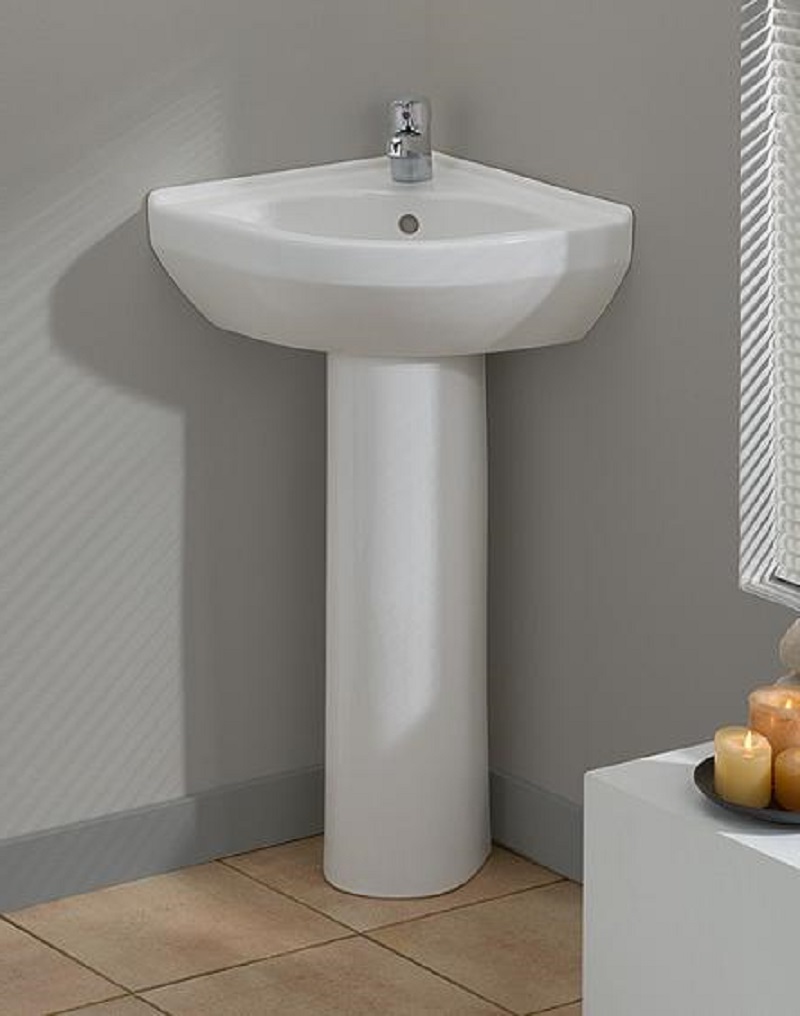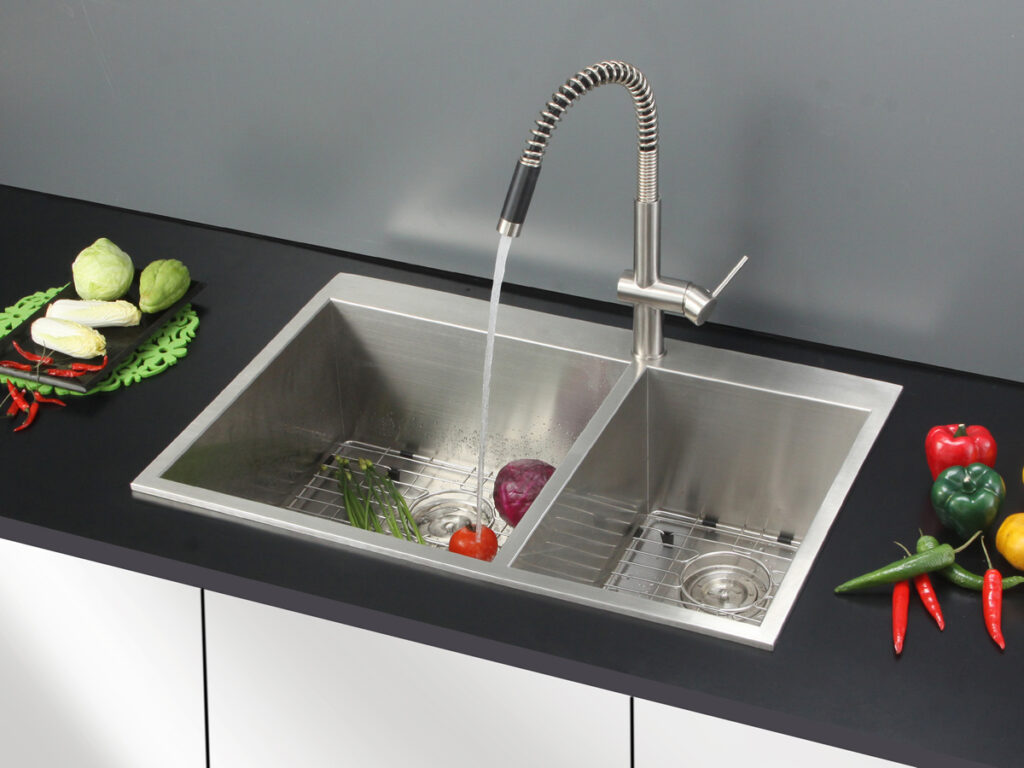An undermount kitchen sink is a popular choice for those who want a sleek and modern look in their kitchen. This type of sink is installed underneath the countertop, making it appear as if it is seamlessly integrated into the surface. The lack of an exposed rim around the sink also makes it easier to clean and maintain. When installing an undermount kitchen sink without a cabinet, you can either use a support frame or attach the sink directly to the countertop using epoxy adhesive. Both methods require careful measurements and precise cutting of the countertop to ensure a perfect fit.1. Undermount Kitchen Sink
If you have limited space in your kitchen, a wall-mounted kitchen sink may be the perfect solution for you. This type of sink is attached directly to the wall, eliminating the need for a cabinet. It also frees up floor space, making your kitchen look more spacious and organized. When installing a wall-mounted kitchen sink, it is important to ensure that the wall can support the weight of the sink and any additional weight from dishes and water. You may also need to hire a plumber to install the necessary plumbing fixtures.2. Wall-Mounted Kitchen Sink
A farmhouse kitchen sink, also known as an apron sink, is a popular choice for those looking to add a touch of rustic charm to their kitchen. This type of sink extends beyond the edge of the countertop, making it the focal point of the kitchen. It is usually made of materials such as porcelain, fireclay, or stainless steel. When installing a farmhouse kitchen sink without a cabinet, you will need to create a custom support structure to hold the sink in place. This can be done using a combination of wood and metal braces.3. Farmhouse Kitchen Sink
A freestanding kitchen sink is a versatile option that can be moved around and placed wherever it is needed. This type of sink usually comes with its own base or stand, eliminating the need for a cabinet. It is a great choice for smaller kitchens or outdoor cooking areas. When installing a freestanding kitchen sink, make sure to choose a sturdy base that can support the weight of the sink and any additional weight from dishes and water. You may also need to install a drain and water supply for the sink to function properly.4. Freestanding Kitchen Sink
A corner kitchen sink is a space-saving option for those with limited counter space. As the name suggests, this type of sink is installed in the corner of the kitchen, making use of an otherwise unused area. It can be installed without a cabinet by attaching it directly to the countertop or using brackets to support it from underneath. To ensure a proper fit, it is important to measure the corner where the sink will be installed and choose a sink that fits the space. You may also need to hire a professional to help with the installation process.5. Corner Kitchen Sink
A pedestal kitchen sink is a classic and elegant choice for those looking to add a touch of vintage charm to their kitchen. It consists of a sink basin supported by a pedestal or column, eliminating the need for a cabinet. This type of sink is usually made of porcelain or fireclay. To install a pedestal kitchen sink without a cabinet, you will need to create a custom support structure for the sink. This can be done using wooden braces or metal brackets.6. Pedestal Kitchen Sink
A drop-in kitchen sink, also known as a top-mount sink, is a popular and budget-friendly option for those looking to install a sink without a cabinet. This type of sink is dropped into a hole cut in the countertop, with the edges of the sink resting on top of the counter. It is easy to install and can be done without professional help. When installing a drop-in kitchen sink, make sure to measure the hole in the countertop accurately to ensure a snug fit. You may also need to install a faucet and drain before securing the sink in place.7. Drop-In Kitchen Sink
A vessel kitchen sink is a stylish and modern option that can add a touch of sophistication to your kitchen. This type of sink sits on top of the countertop, making it the focal point of the room. It is usually made of materials such as porcelain, glass, or stone. To install a vessel kitchen sink without a cabinet, you will need to create a custom support structure for the sink. This can be done using a combination of metal brackets and wooden braces. Make sure to also install a drain and faucet before securing the sink in place.8. Vessel Kitchen Sink
A trough kitchen sink is a great option for those with large families or those who love to entertain. It is a long and narrow sink that can accommodate multiple users at once. This type of sink can be installed without a cabinet by attaching it directly to the countertop or creating a custom support structure. When installing a trough kitchen sink, make sure to choose a sink that fits your countertop and can accommodate your needs. You may also need to install a faucet and drain before securing the sink in place.9. Trough Kitchen Sink
An apron front kitchen sink, also known as a farmhouse sink, is a stylish and functional option for those looking to add a touch of charm to their kitchen. It is similar to a farmhouse sink, but with a more modern and streamlined design. This type of sink can be installed without a cabinet by creating a custom support structure. When installing an apron front kitchen sink, make sure to choose a sink that fits your countertop and complements your kitchen's overall aesthetic. You may also need to install a faucet and drain before securing the sink in place. Now that you know the top 10 main ideas for installing a kitchen sink without a cabinet, you can choose the one that best fits your needs and budget. Whether you prefer a sleek and modern look or a more rustic and charming style, there is a sink option for everyone. Just make sure to measure and plan carefully before starting the installation process to ensure a smooth and successful project.10. Apron Front Kitchen Sink
The Benefits of Installing a Kitchen Sink Without a Cabinet in Your Home

Maximizing Space and Functionality
 When it comes to designing a functional and efficient kitchen, every inch of space matters. This is where the idea of installing a kitchen sink without a cabinet can be beneficial. By removing the traditional cabinet underneath the sink, you free up more space for storage or other kitchen appliances. You can also opt for a smaller sink, allowing for more countertop space, which can come in handy when preparing meals or hosting gatherings. This not only makes your kitchen look more spacious, but it also increases its functionality.
When it comes to designing a functional and efficient kitchen, every inch of space matters. This is where the idea of installing a kitchen sink without a cabinet can be beneficial. By removing the traditional cabinet underneath the sink, you free up more space for storage or other kitchen appliances. You can also opt for a smaller sink, allowing for more countertop space, which can come in handy when preparing meals or hosting gatherings. This not only makes your kitchen look more spacious, but it also increases its functionality.
Modern and Sleek Design
 Gone are the days of bulky and outdated kitchen cabinets. Many homeowners are now opting for a modern and sleek look for their kitchen, and a kitchen sink without a cabinet can help achieve this aesthetic. It creates a minimalist and open concept, giving your kitchen a more spacious and contemporary feel. You can also choose from a variety of sink designs, such as farmhouse sinks, undermount sinks, or even a sleek stainless steel sink, to complement your kitchen's overall look.
Gone are the days of bulky and outdated kitchen cabinets. Many homeowners are now opting for a modern and sleek look for their kitchen, and a kitchen sink without a cabinet can help achieve this aesthetic. It creates a minimalist and open concept, giving your kitchen a more spacious and contemporary feel. You can also choose from a variety of sink designs, such as farmhouse sinks, undermount sinks, or even a sleek stainless steel sink, to complement your kitchen's overall look.
Cost-Effective Option
 Installing a kitchen sink without a cabinet can also be a cost-effective option for homeowners. Traditional kitchen cabinets can be expensive, and the cost can add up when you factor in the installation and labor fees. By eliminating the need for a cabinet, you not only save money on the cabinet itself, but you also save on installation costs. This allows you to allocate your budget towards other areas of your kitchen renovation or even splurge on a higher quality sink.
Installing a kitchen sink without a cabinet can also be a cost-effective option for homeowners. Traditional kitchen cabinets can be expensive, and the cost can add up when you factor in the installation and labor fees. By eliminating the need for a cabinet, you not only save money on the cabinet itself, but you also save on installation costs. This allows you to allocate your budget towards other areas of your kitchen renovation or even splurge on a higher quality sink.
Easy Maintenance and Accessibility
 One major advantage of a kitchen sink without a cabinet is the ease of maintenance and accessibility. Traditional cabinets can be a breeding ground for mold and mildew, especially in areas with high moisture levels, such as the kitchen. Without a cabinet, you eliminate this issue and have easier access to the plumbing and sink for cleaning and maintenance. This can save you time and effort in the long run and ensure a more hygienic kitchen.
One major advantage of a kitchen sink without a cabinet is the ease of maintenance and accessibility. Traditional cabinets can be a breeding ground for mold and mildew, especially in areas with high moisture levels, such as the kitchen. Without a cabinet, you eliminate this issue and have easier access to the plumbing and sink for cleaning and maintenance. This can save you time and effort in the long run and ensure a more hygienic kitchen.
Customizable Options
 With a traditional kitchen cabinet, you are limited to standard sizes and designs. However, with a kitchen sink without a cabinet, you have more customizable options. You can choose the size and shape of your sink, as well as the material and color to match your kitchen's overall design. This allows for a more personalized and unique touch to your kitchen.
In conclusion, installing a kitchen sink without a cabinet can bring many benefits to your home. From maximizing space and functionality to a modern and sleek design, it is a cost-effective and customizable option for any homeowner. Consider this idea when designing your kitchen to create a functional and aesthetically pleasing space for your daily needs.
With a traditional kitchen cabinet, you are limited to standard sizes and designs. However, with a kitchen sink without a cabinet, you have more customizable options. You can choose the size and shape of your sink, as well as the material and color to match your kitchen's overall design. This allows for a more personalized and unique touch to your kitchen.
In conclusion, installing a kitchen sink without a cabinet can bring many benefits to your home. From maximizing space and functionality to a modern and sleek design, it is a cost-effective and customizable option for any homeowner. Consider this idea when designing your kitchen to create a functional and aesthetically pleasing space for your daily needs.



















































































































